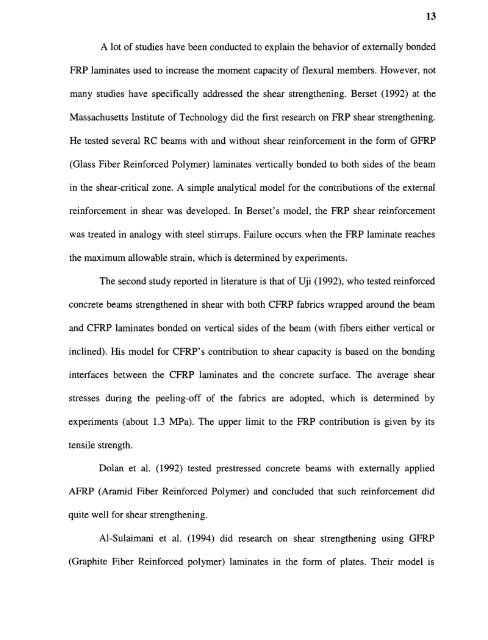njit-etd2003-032 - New Jersey Institute of Technology
njit-etd2003-032 - New Jersey Institute of Technology
njit-etd2003-032 - New Jersey Institute of Technology
Create successful ePaper yourself
Turn your PDF publications into a flip-book with our unique Google optimized e-Paper software.
13<br />
A lot <strong>of</strong> studies have been conducted to explain the behavior <strong>of</strong> externally bonded<br />
FRP laminates used to increase the moment capacity <strong>of</strong> flexural members. However, not<br />
many studies have specifically addressed the shear strengthening. Berset (1992) at the<br />
Massachusetts <strong>Institute</strong> <strong>of</strong> <strong>Technology</strong> did the first research on FRP shear strengthening.<br />
He tested several RC beams with and without shear reinforcement in the form <strong>of</strong> GFRP<br />
(Glass Fiber Reinforced Polymer) laminates vertically bonded to both sides <strong>of</strong> the beam<br />
in the shear-critical zone. A simple analytical model for the contributions <strong>of</strong> the external<br />
reinforcement in shear was developed. In Berset's model, the FRP shear reinforcement<br />
was treated in analogy with steel stirrups. Failure occurs when the FRP laminate reaches<br />
the maximum allowable strain, which is determined by experiments.<br />
The second study reported in literature is that <strong>of</strong> Uji (1992), who tested reinforced<br />
concrete beams strengthened in shear with both CFRP fabrics wrapped around the beam<br />
and CFRP laminates bonded on vertical sides <strong>of</strong> the beam (with fibers either vertical or<br />
inclined). His model for CFRP's contribution to shear capacity is based on the bonding<br />
interfaces between the CFRP laminates and the concrete surface. The average shear<br />
stresses during the peeling-<strong>of</strong>f <strong>of</strong> the fabrics are adopted, which is determined by<br />
experiments (about 1.3 MPa). The upper limit to the FRP contribution is given by its<br />
tensile strength.<br />
Dolan et al. (1992) tested prestressed concrete beams with externally applied<br />
AFRP (Aramid Fiber Reinforced Polymer) and concluded that such reinforcement did<br />
quite well for shear strengthening.<br />
Al-Sulaimani et al. (1994) did research on shear strengthening using GFRP<br />
(Graphite Fiber Reinforced polymer) laminates in the form <strong>of</strong> plates. Their model is

















